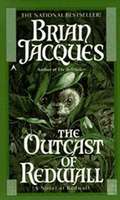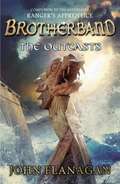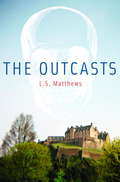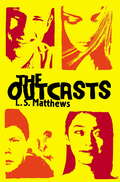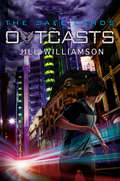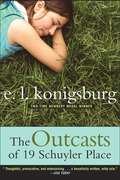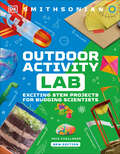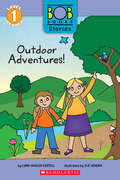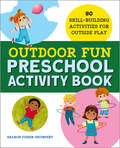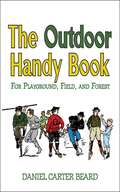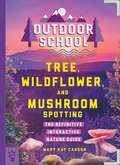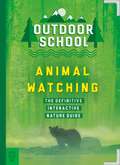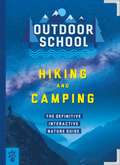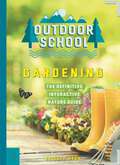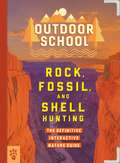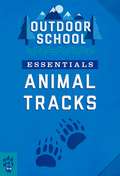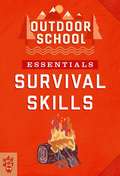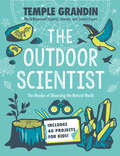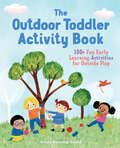- Table View
- List View
Outcast of Redwall (Redwall, Book #8)
by Brian JacquesWhen ferret Swartt Sixclaw and his arch enemy Sunflash the Mace swear a pledge of death upon each other, a young creature is cruelly banished from the safety of Redwall. As he grows, he seeks revenge on the people of Redwall and finds himself embroiled in a hostile battle with far-reaching consequences.
The Outcast Ones
by Grace Bridges Maya ShepherdAfter World War 3, Earth is in ruins. The last surviving humans are barricaded inside safety zones to protect themselves from the radiation.They can only stay alive if they follow strict rules. No one has property of their own, and no one can make their own choices: the Legion Commanders take every decision away from people. This world has no room for emotion. People only live in order to function, so they have numbers instead of names. D518 is one of them. Born into this destroyed world, she's never known any other life than this - completely defined and controlled. But this changes in an instant when she is kidnapped by opponents of the government, and she discovers that everything she believed in is a lie.
The Outcasts (Brotherband Chronicles #1)
by John FlanaganFrom the author of the global phenomenon Ranger's Apprentice! <P> They are outcasts. Hal, Stig, and the others - they are the boys the others want no part of. Skandians, as any reader of Ranger's Apprentice could tell you, are known for their size and strength. Not these boys. Yet that doesn't mean they don't have skills. And courage - which they will need every ounce of to do battle at sea against the other bands, the Wolves and the Sharks, in the ultimate race. The icy waters make for a treacherous playing field... especially when not everyone thinks of it as playing. John Flanagan, author of the international phenomenon Ranger's Apprentice, creates a new cast of characters to populate his world of Skandians and Araluens, a world millions of young readers around the world have come to know and admire. Full of seafaring adventures and epic battles, Book 1 of The Brotherband Chronicles is sure to thrill readers of Ranger's Apprentice while enticing a whole new generation just now discovering the books. <P> Perfect for fans of J. R. R. Tolkien's Lord of the Rings, T. H. White's The Sword in the Stone, Christopher Paolini's Eragon series, and George R. R. Martin's Game of Thrones/A Song of Ice and Fire series. .
The Outcasts
by John A. FlanaganFrom the author of the global phenomenon Ranger's Apprentice!They are outcasts. Hal, Stig, and the others - they are the boys the others want no part of. Skandians, as any reader of Ranger's Apprentice could tell you, are known for their size and strength. Not these boys. Yet that doesn't mean they don't have skills. And courage - which they will need every ounce of to do battle at sea against the other bands, the Wolves and the Sharks, in the ultimate race. The icy waters make for a treacherous playing field . . . especially when not everyone thinks of it as playing. John Flanagan, author of the international phenomenon Ranger's Apprentice, creates a new cast of characters to populate his world of Skandians and Araluens, a world millions of young readers around the world have come to know and admire. Full of seafaring adventures and epic battles, Book 1 of The Brotherband Chronicles is sure to thrill readers of Ranger's Apprentice while enticing a whole new generation just now discovering the books.Perfect for fans of J.R.R. Tolkien's Lord of the Rings, T.H. White's The Sword in the Stone, Christopher Paolini's Eragon series, and George R. R. Martin's Game of Thrones/A Song of Ice and Fire series.
The Outcasts
by John A. FlanaganFrom the author of the global phenomenon Ranger's Apprentice!They are outcasts. Hal, Stig, and the others - they are the boys the others want no part of. Skandians, as any reader of Ranger's Apprentice could tell you, are known for their size and strength. Not these boys. Yet that doesn't mean they don't have skills. And courage - which they will need every ounce of to do battle at sea against the other bands, the Wolves and the Sharks, in the ultimate race. The icy waters make for a treacherous playing field . . . especially when not everyone thinks of it as playing. John Flanagan, author of the international phenomenon Ranger's Apprentice, creates a new cast of characters to populate his world of Skandians and Araluens, a world millions of young readers around the world have come to know and admire. Full of seafaring adventures and epic battles, Book 1 of The Brotherband Chronicles is sure to thrill readers of Ranger's Apprentice while enticing a whole new generation just now discovering the books.Perfect for fans of J.R.R. Tolkien's Lord of the Rings, T.H. White's The Sword in the Stone, Christopher Paolini's Eragon series, and George R. R. Martin's Game of Thrones/A Song of Ice and Fire series.
The Outcasts
by L. S. MatthewsIz and Joe never get to go on school trips, especially not residential ones. They don#xE2;#xAC;"t mean to get themselves excluded, but still no one ever wants to take them. Mia isn#xE2;#xAC;"t usually included in anything. She just doesn#xE2;#xAC;"t see the world in the same way that other people do. Helen doesn#xE2;#xAC;"t know if she#xE2;#xAC;"ll be able to go on the trip. Her brothers and sisters often don#xE2;#xAC;"t leave her any time to herself. And Chris wouldn#xE2;#xAC;"t have gone, either, if he#xE2;#xAC;"d known what he was letting himself in for. This particular trip will take them further than any of them had imagined . . .
The Outcasts
by L S MatthewsIz and Joe never get to go on school trips, especially not residential ones. They don't mean to get themselves excluded, but still no one ever wants to take them. Mia isn't usually included in anything. She just doesn't see the world in the same way that other people do. Helen doesn't know if she'll be able to go on the trip. Her brothers and sisters often don't leave her any time to herself. And Chris wouldn't have gone, either, if he'd known what he was letting himself in for.This particular trip will take them further than any of them had imagined ...
The Outcasts
by L.S. MatthewsIz and Joe never get to go on school trips, especially not residential ones. They don't mean to get themselves excluded, but still no one ever wants to take them. Mia isn't usually included in anything. She just doesn't see the world in the same way that other people do. Helen doesn't know if she'll be able to go on the trip. Her brothers and sisters often don't leave her any time to herself. And Chris wouldn't have gone, either, if he'd known what he was letting himself in for.This particular trip will take them further than any of them had imagined ...
Outcasts
by Jill WilliamsonUncovering the truth could cost them their lives. Since entering the Safe Lands, Mason has focused on two things: finding a way to free his village from captivity, and finding a cure for the disease that ravages many within the walls of the Safe Lands. After immune-suppressive drugs go missing in the clinic, Mason discovers his coworker, Ciddah, may know more about the Safe Lands than imagined … and may have an agenda of her own. At the same time, Mason’s brother Levi is focused on a way to free the remaining Glenrock captives, while Mason’s younger brother Omar decides to take the rebellion against the Sale Lands into his own hands as a vigilante. Soon all three brothers are being watched closely—and when Mason stumbles onto a shocking secret about the Safe Lands meds, his investigation just might get those closest to him liberated.
The Outcasts of 19 Schuyler Place
by E. L. KonigsburgE.L. Konigsburg revisits the town of Epiphany to tell the story of Margaret Rose Kane, Connor's older half-sister. It's about the summer when Margaret Rose turned twelve--the same year that Cabbage Patch dolls were popular, that Sally Ride became the first woman to go into space, that El Nino turned the world upside-down. Margaret Rose begins her summer with a miserable experience at camp, from which she's rescued by her beloved, eccentric uncles. Little does she know that her uncles, in turn, need rescuing themselves--from a tyrannical city council determined to tear down her uncles' life work--three spectacularly beautiful towers that her uncles have been building since before Margaret was a baby. A rousing book about intelligence, art, and the fierce preservation of individuality, from EL Konigsburg.they truly are: irreplaceable works of art. To Margaret, the towers sing. They sing of the joy of making something big and beautiful out of bits and pieces; of integrity; but perhaps most important of all, they sing of history. And Margaret Rose is determined to make sure they always will. This companion story to the acclaimed Silent to the Bone is a rousing tale of art, history, and the fierce preservation of individuality, as only the incomparable E. L. Konigsburg could write it.
Outdoor Activity Lab 2nd Edition (DK Activity Lab)
by Jack ChallonerWith a foreword by Robert Winston, this fun, fact-filled book is brimming with exciting outdoor experiments to help budding boffins explore the science in their own surroundings.Using easy-to-find household items, you can make giant bubbles to reveal how surface tension works, construct a water rocket and blast it skyward to learn about Newton's law of physics, discover how mushrooms grow by cultivating mycelium, and make your own barometer to measure atmospheric pressure ... and much more!Great photography, succinct step-by-step instructions, and rigorous attention to detail will make young scientists excited from the get-go. There is a clear How it works explanation for each project, revealing the fascinating science behind it, along with real-world examples that show everyday science in action.With 25 amazing projects to inspire young scientists and outdoor enthusiasts, Outdoor Activity Lab takes readers out of the house on a journey to better understand their world—perfect for every young scientist curious about the world.
Outdoor Adventures! (Scholastic Reader, Level 1)
by Lynn Maslen KertellCelebrate the great outdoors in this Scholastic Level 1 Reader from the creators of the beloved Bob Books® learn-to-read phonics box sets. Perfect for reading alongside the Stage 3 Bob Books box sets, or for any child reading at Guided Reading Level G.Jack and Anna go on a hike. They duck under trees, hop over streams, and see many animals along the way. They wish they could go on a hike the next day, too, but Mom says no. Can they have their own outdoor adventure in their backyard?Bob Books Stories include:Words that children can sound out (decode); both short and long vowelsSight wordsSimple sentence structuresSimple, colorful, friendly illustrations that support children’s reading and add fun!Longer stories than the books in the Bob Books box sets, which helps children build reading enduranceBob Books has been helping children learn to read through simple phonics and playful text and illustrations for more than forty years. Your child will soon join the millions of happy kids who say, “I read the whole book!”®
Outdoor Farm, Indoor Farm
by Lindsay H. MetcalfDiscover how both outdoor and indoor farms sustainably grow the food we eat throughout the year in this vibrant, rhyming picture book.Outdoor farm, tractors toil.Indoor farm,zero soil.With energetic, enchanting verse and sunshiny, colorful illustrations, discover how the food you eat is grown both outside—and inside! Join two children as they explore the inner workings of an outdoor farm and an indoor farm. You&’ll see how a variety of amazing machinery like tractors and drones along with innovative farming techniques yield the wonderful food we all love to enjoy.
Outdoor Fun (Fountas & Pinnell Classroom, Guided Reading)
by Claudea O’DonnellNIMAC-sourced textbook. When I Go Outside … What are the things you like to do when you go outside?
Outdoor Fun Preschool Activity Book: 80 Skill-Building Activities for Outside Play
by Sharon Fisher-ShumpertBoost preschool skills with fun outdoor activities for kids 3 to 5 Kids learn best through play, and what better place to play than the great outdoors? This preschool activity book delivers hands-on projects that are easy to set up outside and inspire creative thinking. Little ones will strengthen their skills in letters, numbers, social development, and more with this standout among outdoor books. Supplement preschool learning with engaging activities kids can do at the park, beach, or backyard, and set the foundation for independent play. What sets this preschool book apart from other educational books: Learning through play—Kids will build their skills with 80 unique activities, like Scoot Ball and Pinecone Painters, which help with fine motor skills and sensory development. Year-round activities—Find a collection of outdoor projects fit for any season, so children can learn STEM concepts, movement, crafts, and more—no matter what the weather brings. Growth at a glance—Handy icons and labels throughout this best-in-class toddler activity book indicate what skills and subjects each activity helps improve. Give kids more reasons to love playing outside with this fun and educational preschool activity book.
The Outdoor Handy Book: For Playground, Field, and Forest
by Daniel Carter BeardIngenuity and self-reliance are valuable qualities in a boy or man," writes famed outdoorsman Daniel Carter Beard. And what better way to foster them than by working-or playing-with your hands? For fathers who want to build the model ships (or real boats!) they never knew how to build, and sons who want to build the ultimate snow fort, The Outdoor Handy Book is a perfect compendium of wisdom and mischief. In its pages are directions for flying paper dragons, stilt-walking, playing dozens of ball games, building doghouses, capturing butterflies and frogs, and much more. Fully illustrated, and replete with notes to make sure that your fun is varied, continuous, and instructional in every season of the year, The Outdoor Handy Book is great all-ages activities resource, whether you're at the workbench or communing with nature.
Outdoor School: The Definitive Interactive Nature Guide (Outdoor School)
by Mary Kay CarsonWith 448 full-color, highly-illustrated pages, Outdoor School is your indispensable tool for the outdoors. This interactive field guide to plant and mushroom spotting includes:- Immersive activities to get you exploring- Write-in sections to journal about experiences- Next-level adventures to challenge even seasoned nature lovers.No experience is required—only curiosity and courage. Inside you’ll find easy-to-follow instructions on how to:- Grow mushrooms with cardboard- Compare bark types- Count tree rings- Survey leaf patterns- Create fern spore prints- Press and preserve wildflowersAnd so much more!
Outdoor School: The Definitive Interactive Nature Guide (Outdoor School)
by Mary Kay CarsonRewild your life! With metal corners and 448 full-color, highly illustrated pages, OUTDOOR SCHOOL: ANIMAL WATCHING is an indispensable tool for young explorers and animal lovers.Make every day an adventure with the included:- Immersive activities to get you exploring- Write-in sections to journal about experiences- Next-level adventures to challenge even seasoned nature loversNo experience is required—only curiosity and courage. This interactive field guide to animals includes:- Animal tracking- Identifying birds by silhouette, size, and color- Reading animal range maps- Bird nest spotting- Essential animal-watching gear- Identifying mammals- Bird calls and animal sounds- Finding amphibians, reptiles, and fish- Spotting scat- Recognizing eyeshine- Recording animal behaviorAnd so much more!
Outdoor School: The Definitive Interactive Nature Guide (Outdoor School)
by Jennifer Pharr Davis Haley BlevinsRewild your life! With metal corners and 448 full-color, highly illustrated pages, OUTDOOR SCHOOL: HIKING AND CAMPING is an indispensable tool for young explorers and nature lovers.Make every day an adventure with the included:- Immersive activities to get you exploring- Write-in sections to journal about experiences- Next-level adventures to challenge even seasoned nature loversNo experience is required—only curiosity and courage. This interactive field guide to hiking and camping includes:- Planning your next adventure- Essential outdoor gear- First aid & survival- Navigation- How to handle extreme weather- Crossing dangerous terrain- Setting up camp- Building a fire in rain or shine- Games for the trail- Finding and filtering water- Animal tracks, calls, and sounds- Bird watching- Plant spotting- Rock hunting- What to do if you’re lostAnd so much more!
Outdoor School: The Definitive Interactive Nature Guide (Outdoor School)
by Bridget HeosIn this next gift-worthy, full-color, definitive guide in the Outdoor School line, discover the rich possibilities of gardening.With over 400 pages of full-color, highly illustrated pages, Outdoor School is your indispensable tool for the outdoors. Fully illustrated, highly designed, gorgeous and interactive, this field guide to gardening includes:- Immersive activities to get you growing- Write-in sections to journal about experiences- Next-level adventures to challenge even seasoned gardenersNo experience is required—only curiosity and courage. Inside you’ll find easy-to-follow instructions on how to:- Sprout plants from seed- Grow plants indoors and outdoors- Create delicious combinations of herbs and vegetables- Care for fruits, vegetables, flowers, herbs, and beyond- Design the garden of your dreams and so much more!
Outdoor School: The Definitive Interactive Nature Guide (Outdoor School)
by Jennifer SwansonRewild your life! With metal corners and 448 full-color, highly illustrated pages, OUTDOOR SCHOOL: ROCK, FOSSIL, AND SHELL HUNTING is an indispensable tool for young explorers and rock collectors.Make every day an adventure with the included:- Immersive activities to get you exploring- Write-in sections to journal about experiences- Next-level adventures to challenge even seasoned nature loversNo experience is required—only curiosity and courage. This interactive field guide to rocks, fossils & shells includes:- Digging, chiseling, hammering, and wading for rocks and minerals- Identifying rocks & minerals by location, texture, color, shape, and size- Determining between rocks, geodes, and space rocks- Finding fossils and setting up a dig site- Searching and snorkeling for shells- Storing and displaying your collectionAnd so much more!
Outdoor School Essentials: Animal Tracks (Outdoor School)
by Odd DotOUTDOOR SCHOOL ESSENTIALS: ANIMAL TRACKS is your must-have companion to the wild. These pocket-sized books from Odd Dot have quick references for what you need to know while on your next outdoor adventure.Flip through for simple diagrams and full-color illustrations on animal, reptile, and fish spotting, animal tracks, and so much more.Made of durable Tyvek material, these books are meant to last through any adventure! Waterproof and tear-proof makes these the perfect pocket-sized trove of information for kids to take outside. They're also 100% washable and 100% fun!Easy to digest at a glance, these travel-friendly books are made even more beautiful with full-color, vintage-inspired art and highly visual diagrams.
Outdoor School Essentials: Survival Skills (Outdoor School)
by Odd DotOUTDOOR SCHOOL ESSENTIALS: SURVIVAL SKILLS is your must-have companion to the wild! These pocket-sized books from Odd Dot have quick references for what you need to know while on your next outdoor adventure. Flip through for simple diagrams and full-color illustrations on pitching tents, making a fire, first-aid, poisonous plants, dangerous animals, and more.Made of durable Tyvek material, these books are meant to last through any adventure! Waterproof and tear-proof makes these the perfect pocket-sized trove of information for kids to take outside. They're also 100% washable and 100% fun!Easy to digest at a glance, these travel-friendly books are made even more beautiful with full-color, vintage-inspired art and highly visual diagrams.
The Outdoor Scientist: The Wonder of Observing the Natural World
by Temple GrandinFrom New York Times bestselling author and world-renowned scientist and autism spokesperson Temple Grandin comes a book about exploring the world around us, asking questions, and making sense of what we see--with 40 fun outdoor activities that promote independent thinking, which kids can enjoy all year round!What are the aerodynamics of skipping stones or the physics of making sandcastles? Do birds use GPS to navigate their migratory routes? In this book, Dr. Temple Grandin, an inventor and world-renowned scientist, introduces readers to geologists, astrophysicists, oceanographers, and many other scientists who unlock the wonders of the natural world. She shares her childhood experiences and observations, whether on the beach, in the woods, working with horses, or gazing up at the night sky. This book explores all areas of nature and gives readers the tools to discover even more on their own.With forty projects to give readers a deeper understanding of the world around them, from the depths of space to their own backyard, this is a perfect read for budding scientists, inventors, and creators! Praise for The Outdoor Scientist:"Grandin&’s words are a rallying cry for budding scientists and she serves as a role model for young readers with autism. This is an important STEM and STEAM resource for every collection." --School Library Journal "The book is chock-full of information . . . the kind a nature-loving child will be thrilled to discover. An invitation to young readers to observe, enjoy, and learn about the world around us all." --Kirkus Reviews
The Outdoor Toddler Activity Book: 100+ Fun Early Learning Activities for Outside Play (Toddler Activity Books)
by Krissy Bonning-GouldEncourage learning through play with these fun outdoor activities for toddlers aged 1-3. Outdoor play promotes creativity, strengthens muscles, enhances social and emotional development, and makes learning fun. This book is packed with dozens of engaging and educational toddler activities that emphasize early learning and get kids excited about being outside. Each chapter is devoted to a specific type of toddler-friendly play: messy play, active games, nature-based activities, water activities, and outdoor arts and crafts. Bold icons show what each activity teaches your child, allowing you to choose activities appropriate for their developmental stage to help guide their growth. This colorful book of outdoor toddler activities includes: SKILL-BUILDING EXERCISES: Help your little one build up important skills like problem-solving, mindfulness, shapes and letters, sorting, patterns, and many more. ACTIVITY TIPS & TRICKS: Find suggestions for making the most out of each activity and "Caution!" labels for exercises that require increased supervision. DEVELOPMENTAL MILESTONES: Learn more about your child's motor, language, and social-emotional skills at each stage of development. Add more intentional play, meaningful connection, learning opportunities, and plain old fun to your toddler's days with help from The Outdoor Toddler Activity Book.
